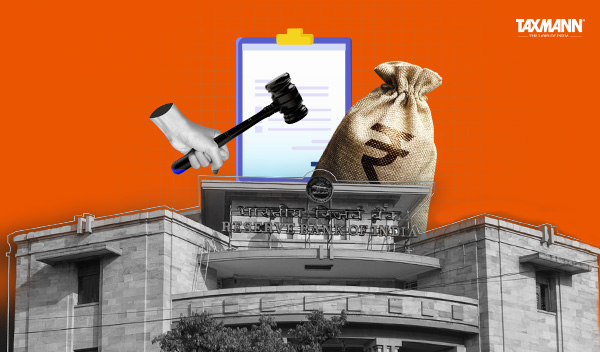The post RBI Invites ‘Theme Neutral’ Applications Under ‘On Tap’ Facility of the Regulatory Sandbox appeared first on Taxmann Blog.
]]>
Press Release: 2025-2026/75, Dated 09.04.2025
The RBI has announced the launch of a ‘Theme Neutral’ application facility under the On Tap Regulatory Sandbox framework. Entities can apply with innovations across any technology/theme. Illustrative areas include digital financial literacy, digital lending, e-KYC, identity verification, AI, blockchain, ML, smart contracts, tokenisation, financial inclusion, and more. Entities interested may submit their application along with supporting documents via email.
Click Here To Read The Full Press Release
The post RBI Invites ‘Theme Neutral’ Applications Under ‘On Tap’ Facility of the Regulatory Sandbox appeared first on Taxmann Blog.
]]>The post RBI Releases Draft Directions on Stressed Assets, Co-Lending, Gold Loans, and Credit Facilities appeared first on Taxmann Blog.
]]>
Press Release: 2025-2026/69, Dated 09.04.2025
In pursuance of the announcement made in the Statement on Developmental and Regulatory Policies, the Reserve Bank has released the draft Directions. These cover securitisation of stressed asset, co-lending arrangements, lending against gold collateral, and non-fund based credit facilities. Public comments are invited until May 12, 2025, via RBI’s ‘Connect 2 Regulate’ portal or email.
Click Here To Read The Full Press Release
The post RBI Releases Draft Directions on Stressed Assets, Co-Lending, Gold Loans, and Credit Facilities appeared first on Taxmann Blog.
]]>The post Governing Body of IFSC Banking Units Must Meet at Least Once a Quarter, With Flexibility for Additional Meetings | IFSCA appeared first on Taxmann Blog.
]]>
Circular F No. IFSCA-FMPP0BR/8/2025-Banking/001, Dated 08.04.2025
The IFSCA has revised the requirement for meetings of the governing body of IFSC Banking Units (IBUs). The governing body must now meet at least once every financial quarter, with the flexibility to hold additional meetings as needed. This replaces the earlier mandate of meeting at least once each quarter and at least six times in a financial year.
Click Here To Read The Full Circular
The post Governing Body of IFSC Banking Units Must Meet at Least Once a Quarter, With Flexibility for Additional Meetings | IFSCA appeared first on Taxmann Blog.
]]>The post IFSCA Allows Re-Filing of Expired Private Placement Memorandums Under Fund Management Regulations appeared first on Taxmann Blog.
]]>
Circular F. No. IFSCA-IF-10PR/1/2023-Capital Markets/7, Dated 08.04.2025
Earlier, IFSCA had notified IFSCA (Fund Management) Regulations, 2025. Under the FM Regulations, 2025, the validity of PPMs for Venture Capital and Restricted Schemes is extended to 12 months from 6 months under the 2022 Regulations. Now, IFSCA has allowed schemes with expired PPMs before February 19, 2025, a one-time opportunity to re-file within 3 months of the circular. Entities must retain key scheme aspects, allowing only necessary changes for compliance.
Click Here To Read The Full Circular
The post IFSCA Allows Re-Filing of Expired Private Placement Memorandums Under Fund Management Regulations appeared first on Taxmann Blog.
]]>The post IFSCA Notifies Fee Structure for Applicants, REs, and Persons Seeking Guidance Under Informal Guidance Scheme appeared first on Taxmann Blog.
]]>
Circular No. IFSCA-DTFA/1/2025, Dated 08.04.2025
The IFSC Authority has issued a circular prescribing the fee structure for applicants, regulated entities, and persons seeking guidance under the Informal Guidance Scheme. Fees are categorised as application fees, licence/registration/recognition/authorisation fees, annual Recurring fees, activity based fees, processing fees, late fees, and informal Guidance fees. All such fees are to be remitted to IFSCA’s designated account as per the detailed framework.
Click Here To Read The Full Circular
The post IFSCA Notifies Fee Structure for Applicants, REs, and Persons Seeking Guidance Under Informal Guidance Scheme appeared first on Taxmann Blog.
]]>The post RBI Cuts Repo Rate by 25 bps to 6.00% With Immediate Effect appeared first on Taxmann Blog.
]]>
Press Release: 2025-2026/61, Dated 09.04.2025
The RBI’s Monetary Policy Committee, in its 54th meeting under the chairmanship of RBI Governor Shri Sanjay Malhotra, reduced the policy repo rate by 25 basis points to 6.00% with immediate effect. Accordingly, the Standing Deposit Facility (SDF) rate under the Liquidity Adjustment Facility (LAF) stands revised to 5.75%, while the Marginal Standing Facility (MSF) rate and the Bank Rate are adjusted to 6.25%.
Click Here To Read The Full Press Release
The post RBI Cuts Repo Rate by 25 bps to 6.00% With Immediate Effect appeared first on Taxmann Blog.
]]>The post RBI Issues ‘Statement on Developmental and Regulatory Policies’; Proposes Co-Lending Framework for All REs appeared first on Taxmann Blog.
]]>
Press Release: 2025-2026/63, Dated 09.04.2025
The Reserve Bank of India (RBI) has released the ‘Statement on Developmental and Regulatory Policies’ outlining measures on Regulations, Payment Systems, and Fintech. The key highlights include:
(a) Draft Framework to Facilitate Securitisation of Stressed Assets
A prudently structured securitisation transaction can aid in resolving stressed assets by improving risk distribution and offering lenders an exit route. To this end, RBI released a discussion paper in January 2023 seeking stakeholder feedback. Based on the inputs received, a draft framework for the securitisation of stressed assets is now issued for public comment.
(b) Comprehensive Framework for Co-Lending Among Regulated Entities
Currently, co-lending guidelines apply only to bank-NBFC partnerships for priority sector lending. Given the evolving landscape and broader potential of such models, RBI has now proposed a generic regulatory framework covering all co-lending arrangements among regulated entities.
(c) Unified Regulatory Framework for Lending Against Gold Jewellery
RBI has proposed comprehensive regulations on loans against gold jewellery to harmonise prudential and conduct norms across all regulated entities (REs), considering their risk profiles. This move aims to address observed concerns and ensure uniformity.
(d) Enhancing UPI Transaction Limits for Person-to-Merchant Payments
Currently, Unified Payments Interface (UPI) transactions are capped at Rs. 1 lakh, with certain Person-to-Merchant (P2M) use cases allowed higher limits of up to Rs. 2 lakh or Rs. 5 lakh. To support evolving requirements, the NPCI, in consultation with banks and other stakeholders, may revise P2M limits with appropriate safeguards. Banks may continue to set internal limits within the overall cap prescribed by NPCI. Person-to-Person (P2P) transactions will continue to be capped at Rs. 1 lakh.
(e) ‘On Tap’ Application Facility under Theme-Neutral Regulatory Sandbox
The Reserve Bank of India has been operating the Regulatory Sandbox (RS) framework since 2019, with four thematic cohorts completed and a fifth theme-neutral cohort currently open until May 2025. To further encourage innovation, it is now proposed to make the sandbox both ‘Theme Neutral’ and ‘On Tap’, allowing continuous submission of applications for eligible products within RBI’s regulatory scope. This move aims to support ongoing FinTech innovation and adapt to the dynamic regulatory environment.
Click Here To Read The Full Press Release
The post RBI Issues ‘Statement on Developmental and Regulatory Policies’; Proposes Co-Lending Framework for All REs appeared first on Taxmann Blog.
]]>The post RBI Issues Draft Unified Export-Import Norms, Seeks Public Input by Apr 30, 2025 appeared first on Taxmann Blog.
]]>
Press Release: 2025-2026/41, Dated: 04.04.2025
RBI has released draft FEM (Export & Import of Goods & Services) Regulations, 2025, merging export-import rules into one document to simplify compliance and enhance ease of business. It defines clear roles for ADs and mandates structured procedures. Under the new norms, exporters with unrealized proceeds exceeding Rs. 25 crore for more than 2 years can export only against a full advance or an irrevocable Letter of Credit (LC). Advance remittance for gold and silver imports is prohibited. Public feedback is open till 30-04-2025.
Click Here To Read The Full Press Release
The post RBI Issues Draft Unified Export-Import Norms, Seeks Public Input by Apr 30, 2025 appeared first on Taxmann Blog.
]]>The post RBI Launches Verified WhatsApp Channel to Enhance Public Awareness appeared first on Taxmann Blog.
]]>
Press Release: 2025-2026/43; Dated: 04.04.2025
The RBI has been conducting public awareness campaigns across various media platforms, including text messages, television, and digital advertisements, under the ‘RBI Kehta Hai’ initiative. The RBI is now further expanding its outreach by adding WhatsApp as an additional means to deliver public awareness messages. This initiative aims to ensure that vital information reaches people in a simple, direct, and effective manner, strengthening trust & resilience in our digital financial ecosystem.
Click Here To Read The Full Press Release
The post RBI Launches Verified WhatsApp Channel to Enhance Public Awareness appeared first on Taxmann Blog.
]]>The post RBI Keeps FPI Investment Limits in G-Secs, SGSs, and Corporate Bonds Unchanged for FY 2025-26 appeared first on Taxmann Blog.
]]>
Circular no. RBI/2025-26/20 A.P. (DIR Series) Circular No. 01; Dated: 03.04.2025
The RBI has set the investment limits for Foreign Portfolio Investors (FPIs) in debt instruments for the financial year 2025-26. Accordingly, the limits for FPI investments in Government Securities (G-Secs), State Government Securities (SGSs), and corporate bonds shall remain unchanged at 6%, 2%, and 15%, respectively, of the outstanding stocks of securities for the year 2025-26.
Click Here To Read The Full Circular
The post RBI Keeps FPI Investment Limits in G-Secs, SGSs, and Corporate Bonds Unchanged for FY 2025-26 appeared first on Taxmann Blog.
]]>